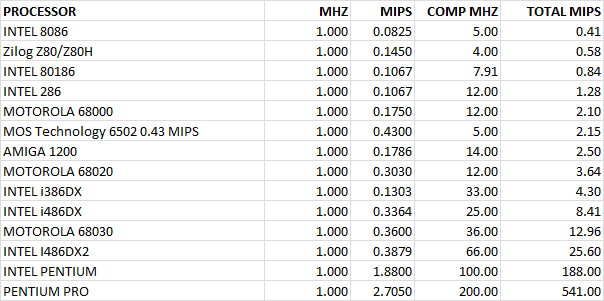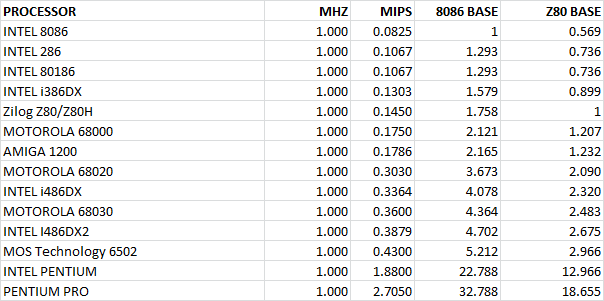Hi Martin,
I have been digging some more about MIPS, from what I can gather an 8 Cycle instruction on 8MHz CPU would be calculated as 8,000,000 / 8 = 1,000,000 instructions per second. = 1 MPS
Which is what I see quoted for the Atari ST M68,000 8 MHz.
Other pieces of information that I found show the following:
"The fastest instruction on the ST takes 4 clocks. It's possible to hit 2 mips using 4 cycle instructions. The Blitter on the ST does steal cycles from the CPU.
50% on an async transfer or 90 - 100% on a synchronous transfer. 90% using the restart method or less if there are interrupts during a transfer."
If I read that correctly and accept that 1 MIPS for the Atari ST is about right then with whatever else the CPU does in the background I can easily see that programs as CP2150 are playing at less than 1 MIPS.
In the chart that I had posted yesterday with 1 MHz 6502 being 2.966 times faster than a Z80, this is also pretty much correct.
Here is a different way to look at the chart:

Below is a rule of thumb that has typically been used for dedicated computer comparisons historically, where it is assumed that the programs are configured optimally on dedicated computers.
6502 5 MHz 1,6 MIPS
68020 20 MHz 4 MIPS
68030 33 MHz 11,9 MIPS
68030 50MHz 18 MIPS
68040 40MHz 44 MIPS
68060 66MHz 94 MIPS
68060 77MHz 110 MIPS
Dedicated computer people consider 68,000 as having half the MIPS of a 68020 therefore a Mephisto 12 MHz 68,000 computer would have approx. 1.2 MIPS which would make it slower than a 6502 5 MHz. But most people also say 5 MHz 6502 dedicated computer equals a 12 Mhz 68,000. Therefore even using the above dedicated chart an Atari ST 8 MHz would be 0.8 MIPS which is very close to the Amiga 0.7 that gets quoted a lot. And, that's assuming that what ever interrupts are happening in the background are not slowing it down even more. ie.. 0.8 MIPS is probably best case.
I don't think that the charts I provided are wrong, they are Drhystone MIPS results which were done all the same for all these systems and relatively speaking match the MIPS that have always been considered for dedicated computers from a comparison between systems perspective.
The difference is more about what really happens in a chess program when it calculates compared to these DMIPS tests and it seems to me there is loss in all cases when chess programs calculate as seen from the DMIPS table the dedicated computer processor list.
ie Motorola 12 MHz = 2.1 MIPS & 6502 5 MHz 2.15 MIPS on chart I provided compared to dedicated 1.6 MIPS versus 1.2 MIPS used by most people as a rule of thumb.
Also here is some information from Wikipedia:
https://en.wikipedia.org/wiki/List_of_I ... processors
8086 = 8 MHz with 0.66 MIPS
80186 = 6 MHz with > 1 MIPS
80286 = 6 MHz with 0.9 MIPS
So would say yes 186 and 286 are similar but not 8086 which seems to be half the speed.
It's all very interesting.
best regards


